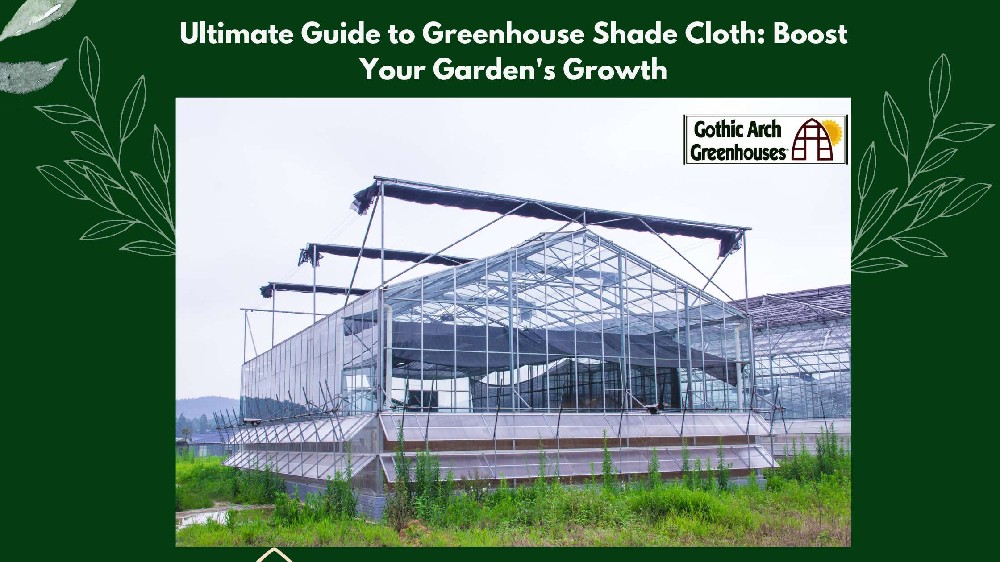Written by H & B . Sierke (Gothic Arch Greenhouses INC.)
Introduction to Greenhouse Shade Cloth
Gardening enthusiasts and professional horticulturists alike understand the crucial role that light regulation plays in plant growth and health. A greenhouse is an excellent way to control the environment in which plants grow, but managing light exposure can be challenging even within this controlled space. This is where greenhouse shade cloth comes into play. This guide will walk you through everything you need about greenhouse shade cloth, from its benefits to installation tips, helping you maximize your greenhouse and gardening potential.
What is Greenhouse Shade Cloth?
Greenhouse shade cloth is a specialized fabric designed to control the amount of sunlight that reaches your plants. Made from durable materials like polyethylene (PE), polypropylene (PP), or polyolefin, it comes in different densities, known as shade percentages, ranging from 30% to 90%. These percentages indicate how much sunlight the cloth blocks, with 30% allowing 70% of sunlight through and 90% blocking nearly all light.
Types of Shade Cloth
There are primarily two types of shade cloths available
Knitted Shade Cloth: Known for its durability and flexibility, this type doesn't unravel when cut, making it easier to install and modify as needed. It's resistant to tearing and comes in various colors.
Woven Shade Cloth: While slightly heavier, this type is strong and provides excellent UV protection. It's ideal for permanent installations.
Benefits of Using Greenhouse Shade Cloth
Protecting Plants from Excessive Heat
One of the main advantages of using shade cloth is its ability to protect plants from excessive heat. During the peak summer months, intense sunlight can cause heat stress, leading to wilting, sunburn, and even plant death in extreme cases. By filtering the sunlight, shade cloth reduces the temperature within the greenhouse, creating a more stable and conducive environment for plant growth.
Preventing UV Damage
UV rays can particularly harm plants, causing cellular damage that impedes growth and productivity. Shade cloth with UV protection blocks harmful rays and extends its lifespan, making it a wise investment for long-term gardening.
Enhancing Photosynthesis
While it might seem counterintuitive, reducing the amount of direct sunlight can enhance photosynthesis. Many plants perform better under diffused light conditions, where light is spread more evenly and penetrates deeper into the plant canopy. This leads to healthier, more robust growth.
Improving Water Retention
Shade cloth helps reduce evaporation rates by lowering the temperature and shielding plants from direct sunlight. This means that the soil retains moisture longer, reducing the need for frequent watering and promoting sustainable gardening practices.
Choosing the Right Shade Cloth for Your Greenhouse
Determining the Appropriate Shade Percentage
The first step in choosing the right shade cloth is determining the appropriate shade percentage. This depends largely on the type of plants you are growing:
- 30%-50%: Ideal for heat-tolerant plants like tomatoes, peppers, and succulents.
- 50%-75%: Suitable for most vegetable gardens, including lettuce, herbs, and root vegetables.
- 75%-90%: Best for delicate plants such as orchids, ferns, and shade-loving perennials.
Considering the Color
Shade cloths come in different colors, primarily black, white, and green. Each color has its benefits:
- Black: Provides maximum shade and heat reduction, ideal for very hot climates.
- White: Reflects sunlight, creating a cooler environment, and is excellent for flowering plants.
- Green: Blends with the natural environment and offers balanced light diffusion, which is suitable for general use.
UV Protection
Ensure that the shade cloth you choose has UV protection. This will help protect your plants and increase the cloth's lifespan, making it more cost-effective in the long run.
Installing Greenhouse Shade Cloth
Materials Needed
To install your shade cloth, you'll need the following materials:
- Shade Cloth: Cut to the size of your greenhouse.
- Scissors or Utility Knife: For cutting the cloth.
- Clips or Fasteners: Attach the cloth to the greenhouse frame.
- Cable Ties or Bungee Cords: These are used to secure the cloth in place.
Step-by-Step Installation Guide
- Measure and Cut: Measure the area of your greenhouse that needs shading and cut the shade cloth to the appropriate size.
- Attach Clips or Fasteners: Attach clips or fasteners to the edges of the shade cloth.
- Secure the Cloth: Use cable ties or bungee cords to secure the cloth to the greenhouse frame. Ensure it is taut to prevent sagging.
- Adjust as Needed: Depending on the season and plant growth, you may need to adjust the positioning or percentage of shade cloth used.
Maintenance Tips
To ensure your shade cloth remains effective and lasts long:
- Regular Cleaning: Dust and debris can accumulate on the cloth, reducing effectiveness. Clean it periodically with a gentle spray of water.
- Inspect for Damage: Check for any tears or wear and repair them promptly to maintain optimal shading.
Maximizing Your Greenhouse's Potential
Using a greenhouse shade cloth is a simple yet effective way to enhance your gardening efforts. By regulating light exposure, you can protect your plants from excessive heat, prevent UV damage, and create an ideal environment for photosynthesis and growth. Whether you're a hobbyist or a professional, the right shade of cloth can make a significant difference in the health and productivity of your plants. Follow the guidelines in this practical guide to choose, install, and maintain your shade cloth, and watch your garden thrive like never before

